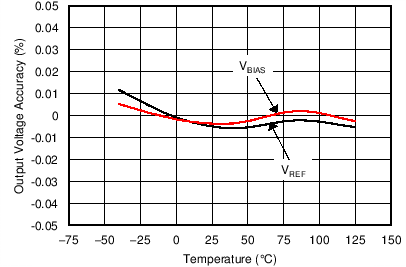ZHCSCM7E July 2018 – February 2022 REF2025 , REF2030 , REF2033 , REF2041
PRODUCTION DATA
- 1 特性
- 2 应用
- 3 说明
- 4 Revision History
- 5 Device Comparison Table
- 6 Pin Configuration and Functions
- 7 Specifications
- 8 Parameter Measurement Information
- 9 Detailed Description
- 10Applications and Implementation
- 11Power-Supply Recommendations
- 12Layout
- 13Device and Documentation Support
- 14Mechanical, Packaging, and Orderable Information
9.3.1 VREF and VBIAS Tracking
Most single-supply systems require an additional stable voltage in the middle of the analog-to-digital converter (ADC) input range to bias input bipolar signals. The VREF and VBIAS outputs of the REF20xx are generated from the same band-gap voltage as shown in the Section 9.2 section. Hence, both outputs track each other over the full temperature range of –40°C to 125°C with an accuracy of 7 ppm/°C (maximum). The tracking accuracy increases to 6 ppm/°C (maximum) when the temperature range is limited to –40°C to 85°C. The tracking error is calculated using the box method, as described by Equation 2:

where
The tracking accuracy is as shown in Figure 9-1.
 Figure 9-1 VREF and VBIAS Tracking vs Temperature
Figure 9-1 VREF and VBIAS Tracking vs Temperature